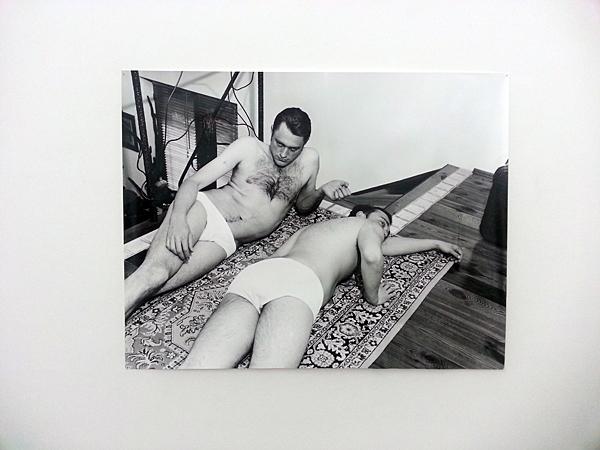This year’s Photography Graduates at the RCA have put together a surprisingly subdued collection of imagery. Not that the RCA was ever shouty, but in previous years the work in the final show always projected insolent confidence, entitlement even, yet in this batch there seems to be a need manifested to look inside the medium, moving away from the figurative and the conceptual to a more abstract, graphic quality. This may well be a reflection of where Photography is at right now; no more play. Where last year’s crop were mostly about challenging traditional presentations of photographic work as well as representations within, this year graduates have given up that ghost, preferring instead to question photographic nature from the inside. Taken altogether, it is an impressive selection.
The first work one encounters is the excellent room shared by Philipp Dorl and Justin Coombes. Dorl’s work is elliptical, ephemeral. Abstract imagery on paper stuck to or pinned to the wall in seemingly random arrangements, dance and skate with one another, furtively suggesting meaning, association or connection but flirtatiously, perhaps without ever meaning to actually deliver. In his Dorl’s own words : ‘When one looks at an image, one’s eyes are constantly moving from one part to another. From the figure to the background. From one perception to the next. And back and forth and back again’

As as graduate of the practice-based PHD, Justin Coombes’s work is suitably cerebral, yet light and airy, not overburdening the viewer with the spiritual symbolism in which he is passionately interested. Already an established artist, Coombes has always been interested in situating mythologies within the urban environment. In this series, Coombes explores the relationship between image and text with 4 light-boxes positioned alongside projected poetry. Coombes is interested in the idea of ‘Ekphrasis’, which is the act of using words to describe a visual image. The light boxes depict (in Coombes’s words) ‘cormorants roosting in trees on a small island in the middle of a lake. Mysterious, human figures stand on either side of the water. The poem projected onto the gallery wall envoices the male figure: he entreats the other to stop enslaving the birds, and using other forms of sorcery, and engage in a more earthly, everyday form of love with him’ . Cormorants have been potent symbols throughout our cultural history, used often to symbolise Christianity. An intriguing, pleasurable set of imagery that intrigues as well as it does satisfy.

In one of the main spaces, Elisabteh Molin has a nice installation which seems to play on the interaction between printed image and technology, in this case mostly analogue. I couldn’t really tell you much more about what the work might be about as her statement is equally bewildering, but it’s a well thought out and enjoyable installation.

Further within the space is the playful performances of Oezden Yorulmaz. In these images, Yorulmaz photographs the figure in a series of poses and stances that are meant to trigger visual memories stored in our collective subconscious. These triggers then lead to either a positive or negative misunderstanding or miscommunication. The mages are excellent, mysterious yet vibrant, and although they may not do exactly what Yorulmaz wants them to, they are reflective of a developed visual sophistication.

For me, Ryan L. Moule’s work was some of the best on show. Beautiful and haunting, his monochrome images are barely visible in their murky, noirish mystery. , Moule’s images are like scratches on the surfaces of the visual membrane, both penetrative and revelatory.

Equally brilliant is the work of Joanna Potrowska. These masterful images explore modes of behaviour within a family, where one’s individuality is both subsumed and extended, performed. Classic in their aesthetic, these clear images smart in their unflinching gaze.
Overall, it’s good to see a move away from conceptual trickery towards a more medium based examination of representation and the nature of the photographic image. One feels that this year, the RCA has given the viewer the credit of some visual understanding, and has moved away from the heavy handed, at least in the cases mentioned here.
Top Photo: Joanna Potrowska
Words/Photos: Kerim Aytac © Artlyst 2013

